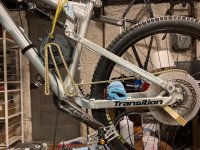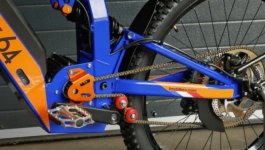DanGT86
100 kW
I know gear reductions through a jackshaft add losses to a system through drag but how does that compare to a single stage with a tensioner? I am trying to compare 2 similar designs.
One design uses a jack shaft to locate the final drive to the pivot point of the bike's suspension to eliminate chain growth during travel. The jackshaft has almost no reduction. Its 18tooth in and 16tooth out to the rear wheel.

The other design would be a single stage from motor to wheel with a 2 sprocket derailleur type tensioner similar to the LMX bikes.

If both designs have the same amount of sprockets and bearings so would they both have equal frictional and inertial losses? If the bearings are equal are the losses just a matter of how many teeth are contacting the chain? Does a jackshaft incur more losses because the chain is under more load on more teeth compared to the relatively small load on derailleur/tensioner teeth?
One design uses a jack shaft to locate the final drive to the pivot point of the bike's suspension to eliminate chain growth during travel. The jackshaft has almost no reduction. Its 18tooth in and 16tooth out to the rear wheel.

The other design would be a single stage from motor to wheel with a 2 sprocket derailleur type tensioner similar to the LMX bikes.

If both designs have the same amount of sprockets and bearings so would they both have equal frictional and inertial losses? If the bearings are equal are the losses just a matter of how many teeth are contacting the chain? Does a jackshaft incur more losses because the chain is under more load on more teeth compared to the relatively small load on derailleur/tensioner teeth?

